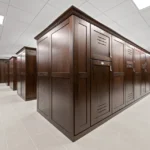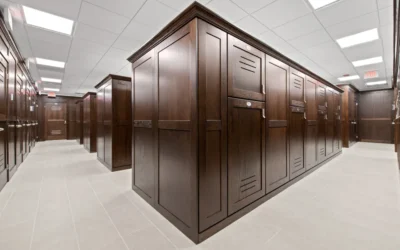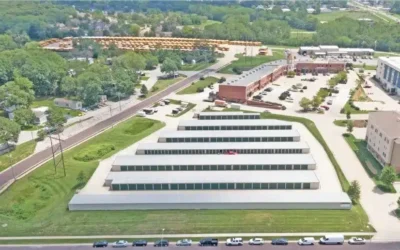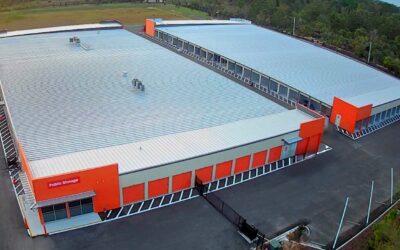Updated 4/16/2024
This page contains statistics about the U.S. self-storage industry compiled by The SpareFoot Storage Beat. Statistics on this page will be updated as we receive new data. If you have data that you would like to share or have a question about data on this page, please email [email protected].
In this report:
- About the Self Storage Industry
- Self-Storage Pricing Trends
- Self Storage Occupancy Trends
- Top Operators of Self-Storage
- Self-Storage Industry Development
- Top Self-Storage Markets
Self Storage Industry Snapshot
| U.S. self-storage industry snapshot | Data |
|---|---|
| Total market size | $44.3 billion |
| Number of self-storage facilities | 52,301 self-storage facilities |
| Total rentable storage space | 2.1 billion square feet |
| Storage space per person | 6.32 square feet |
| Percentage of households that rent a storage unit | 11.1% |
| Average monthly cost for a self-storage unit | $85.14 per month as of March 2024 |
| Average monthly occupancy rate | 83.85% as of March 2024 |
About the Self-Storage Industry
The self-storage industry is composed of a large number of firms engaged in the business of leasing enclosed storage rooms to individuals and businesses on a temporary, month-to-month basis. Renters typically use self-storage units to keep household goods during a move or other life transitions.
Industry ownership is fragmented:
- 37.6% of self-storage space (by rentable square footage) owned by five public companies
- 22.2% is owned by other large and mid-size companies that each operate more than 500,000 square feet of self-storage space.
- 40.2% of storage space is controlled by smaller operators, many of which are small family-owned businesses. (Self-Storage Almanac, 2024)
How big is the self-storage industry?
Overall, the self-storage industry is valued between $44.3 billion according to the 2024 Self-Storage Almanac published by MiniCo Insurance.
When it comes to the physical size of the self-storage industry, here are the most recent stats:
- There are an estimated 52,301 storage facilities operating in the U.S. today. (Self-Storage Almanac, 2024)
- There is an estimated 2,099,000,000 square feet of storage space in operation. (Self-Storage Almanac, 2024)
- That amounts to 6.32 square feet of self-storage space per person in the United States, up from 6.1 square feet per last year. (Self-Storage Almanac, 2024)
- 11.1% of households currently rent a self-storage facility. That is an estimated 14.6 million households. (SSA Demand Study 2023)
Self-Storage Pricing Trends
Self-storage units range in price depending on local supply and demand, market size, unit availability, time of year and amenities. The average monthly cost to rent a self-storage unit was $85.14 in March of 2024, based on SpareFoot reservation data. That marks a decline of 13.6% from the previous year.
National average cost to rent a self-storage unit
The national average cost for all unit sizes was $96.25 per month in 2023. That is a decline of 12.5% from the record of $110.01 set in 2022.
The average price per square foot was $1.01 per square foot in 2023, down from $1.19 the previous year.
National average self-storage rent by unit size
| Unit size | Avg. Monthly Storage Rent (2024 YTD) | $/sq.ft. | Percent share of all units |
|---|---|---|---|
| 5×5 | $37.65 | $1.51 | 17% |
| 10×10 | $89.46 | $0.89 | 20.4% |
| 5×10 | $56.61 | $1.06 | 23% |
| 10×20 | $139.11 | $0.68 | 6.8% |
| 10×15 | $119.17 | $0.79 | 9.9% |
Self-Storage Occupancy Trends
Overall occupancy at stabilized facilities in the self-storage industry was 83.85% as of March 2024, according to Storable data. That is a reduction in occupancy of 3.33% compared to the same month last year.
Top Operators of Self-Storage
More than 37% of self-storage space is controlled by the top five firms, four of which are real estate investment trusts: Extra Space Storage, Public Storage, CubeSmart, and National Storage Affiliates Trust. The fifth, U-Haul, is a publicly traded holding company.
Largest publicly traded storage operators in the U.S. (by annual revenue)
- Public Storage: $3.4 billion (2023)
- Extra Space Storage: $2.56 billion (2023)
- CubeSmart: $1.05 billion (2023)
- National Storage Affiliates Trust: $858 million (2023)
- U-Haul Holding Company: $744 million (fiscal 2023; self-storage revenue only)
Data from most recently reviewed company earnings reports.
Largest self-storage operators in the U.S. (by number of facilities, owned or managed)
In April of 2023, Extra Space Storage acquired Life Storage for approximately $12.7 billion. The deal made the Salt Lake City-based REIT the largest storage company in the industry, displacing longtime leader Public Storage.
- Extra Space Storage: 3,666 facilities
- Public Storage: 3,533 facilities
- U-Haul International: 2,016 facilities
- CubeSmart: 1,338 facilities
- National Storage Affiliates Trust: 1,237 facilities
Data from Self Storage Almanac 2024
Self-Storage Industry Development
In 2023, self-storage construction spending exceed $6.99 billion—an all-time record.
The chart below shows construction spending by month, according to the U.S. Census bureau. Figures are not adjusted for inflation.
Top Self-Storage Markets 2024
Below are the top 10 markets for self-storage based on total reservations for all unit sizes in March 2024:
| Rank | City, State | Price Per Month | % change (YOY) |
|---|---|---|---|
| 1 | Los Angeles, CA | $134.78 | -21.4% |
| 2 | Las Vegas, NV | $80.39 | -12.7% |
| 3 | Phoenix, AZ | $67.05 | -18% |
| 4 | San Diego, CA | $104.56 | -19.5% |
| 5 | Houston, TX | $71.47 | -19% |
| 6 | Miami, FL | $108.69 | -16.7% |
| 7 | New York, NY | $102.74 | -14.5% |
| 8 | San Antonio, TX | $61.33 | -30.8% |
| 9 | Dallas, TX | $68.78 | -27% |
| 10 | Denver, CO | $81.94 | -13% |
Report Sources
Self Storage Association
Self-Storage Almanac
Public Storage
Extra Space Storage
CubeSmart
National Storage Affiliates Trust
U-Haul Holding Company
Storable







